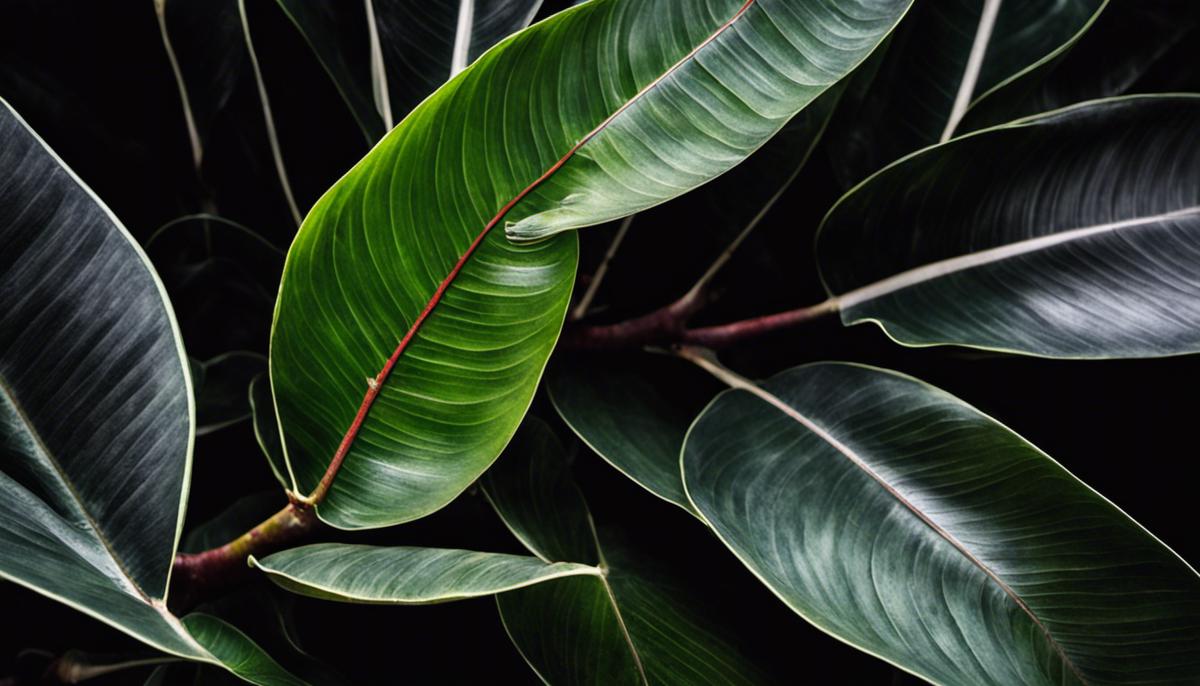
How to grow rubber tree
Description: When it comes to vibrant indoor plantation, the rubber tree plant, or Ficus elastica, holds a prized spot with its impressive height, luscious green leaves, and low maintenance requirements. As an ardent plant enthusiast or a novice green thumb, acquiring a deep understanding of the rubber tree plant's basics, acknowledging best practices related to its planting and care, and getting equipped to troubleshoot common problems are instrumental in fostering robust plant health. This journey will guide you through the plant's origination, optimal climatic conditions, and its unique leaf structure. Furthermore, you'll comprehend selecting the right soil mix and the importance of an ideal pot for growth, consistent watering practices, and the strategic use of fertilizers. Propelling you to leave no stone unturned, this comprehensive guide encapsulates practical insights into identifying and combating common plant issues like leaf drop, browning leaves, prevalent pests, and diseases. There's something quite magical about nurturing a rubber tree plant, isn't there? Watching it grow and flourish and add that refreshing touch of green to living spaces - it's a deeply rewarding experience. For those intrigued by the charm of this particularly robust flora, understanding the essentials about a rubber tree plant, or Ficus elastica, as botanists lovingly refer to it, could prove to be the initiation into a lifelong hobby. First things first - the origin. The rubber tree plant hails from the tropical regions of Southeast Asia, which means it thrives in a warm, humid climate. However, it's proved itself to be a real trooper and can adapt remarkably well to indoor conditions, making it a favorite addition to homes and offices alike. The all-important matter of light conditions. Rubber tree plants adore bright, indirect light. While these plants can survive in lower light conditions, they truly kick up their growth spurt a notch when receiving a good amount of light. However, ensure it's not too harsh, as intense, direct sunlight can burn the leaves causing them distress. Of course, watering is vital. A rubber tree plant loves a good drink, but despise having wet feet. This translates to letting the top inch of the soil dry between watering. If the leaves are drooping, it could be a sign of both overwatering or underwatering, so it's a good idea to always check the soil before reaching for that watering can. Temperature and humidity are equally crucial. Rubber tree plants enjoy a temperature range between 60-80°F and high humidity. So, during those dry, winter months, it's recommended to frequently mist the plant or introduce a humidifier for creating the ideal environment. One could talk endlessly about soil, but in straightforward terms: a well-draining, rich in organic matter soil works absolute wonders. A mixture of peat, pine bark, and coarse sand helps facilitate drainage and prevents waterlogging. Regular household potting soil often work wells too, as long as it's loose, well-draining, and amended with perlite or sand to improve aeration. Feeding the plant isn't an afterthought. A diluted, balanced liquid fertilizer, used every two weeks during the growing season, not only keeps the plant healthy but also boosts leaf production. Always ensure to follow the product-label instructions to avoid over-fertilization. Pruning can shape destiny. If a bushier rubber plant is the goal, pruning the rubber tree helps since it encourages branching. When a stem is cut back, two new shoots usually sprout near the cut, making the plant denser. Always remember to sterilize the pruners before use to avoid spreading diseases. Last of all, let's talk propagation. The rubber tree plant makes propagation straightforward with the cutting method. A stem cutting, sunken in moist potting mix or water, can usher in a new plant marking the journey of a hobbyist to an amateur botanist. So, go ahead, soak up the knowledge and let the fascinating world of rubber tree plants add that exciting challenge to your indoor gardening endeavors. Remember, patience is the gardeners tool, the results may be slow but they are incredibly gratifying. Happy Gardening! The Rubber Tree Plant, hailed from the tropical regions of South America, has become a beloved indoor companion for many green-thumbed enthusiasts. Its adaptability to less than ideal light conditions makes it the perfect companion for those dreary winter days, digging its roots into your heart as it finds its place in the sunlight or partial shade of your home. Now, we’ve already discussed the specifics of watering requirements, but let's delve a little deeper into the subject, because understanding how to water a rubber tree plant is crucial for its overall health. Be it overwatering or underwatering, your plant will always shout out its discomfort through the language of drooping, yellowing, or shedding leaves. Water only when the top inch of soil is dry to the touch, and allow excess water to drain completely to avoid root rot. Temperature fluctuations and humidity are an essential element of Rubber Tree Plant care, but we’ve gone through that - you savvy hobby gardener! You're aware the balmy, unfaltering climes of 60-80°F mimic their native tropics, promoting robust growth. Combined with ideal humidity levels between 50-60%, they recreate the luscious, dew-kissed mornings of an equatorial rainforest. Skipping right along, let's chat about soil! It loves rich, well-draining soil and providing it would make a world of difference in the development and overall wellbeing of the plant. It enjoys a well-structured, somewhat sandy soil that will help avoid water stagnation - a big no-no for your beloved Rubber Tree Plant. To keep your lush new friend thriving and flaunting its dark, glossy leaves, it is paramount to supply it with a balanced liquid fertilizer. This offers a host of essential nutrients, the building blocks, ensuring a healthy and vibrant life for your Rubber Tree Plant. Now for the exciting part - pruning and propagation! Isn't it thrilling to take a piece of the plant and create a whole new one? By making a clean cut on the stem, you've made the first step towards propagation, allowing the 'parent' plant to branch out and your cutting to root, continuing its genetic legacy. Remember, cultivating an indoor garden, especially with Rubber Tree Plants, is not just about the destination but the journey as well. The joy is hidden in the daily routine of checking the soil, adjusting the lighting, and the sheer anticipation of seeing a new leaf unfurl. It's about learning the plant's language, understanding its needs, and witnessing the magic of growth. Happy planting! Now, down to the nitty-gritty of diagnosing and addressing some familiar difficulties that can arise when caring for a beloved rubber tree plant. This phase is just as integral to the hobby as the laid-out groundwork, placing your plant in the perfect lighting conditions or pruning it for aesthetic reasons. The key to success with rubber tree plants, as with many hobbies, is enjoying the process, paying attention, and making minor tweaks when necessary. Don't dismay if your rubber tree plant has a setback. Instead, view it as an opportunity to delve even deeper into understanding and nurturing this fabulous species. The joy is genuinely in the journey, not the destination. After all, that's the heart and soul of indoor gardening. Happy growing! Understanding and nurturing a living organism involve a symbiosis that not only complements the surrounding but also enhances inner well-being. In this journey, you got acquainted with the rubber tree plant's essentials, understood how to provide it with the optimal care and identified potential problems that could deter its growth. Immersing yourself into the intuitive world of plant care, you've gained new insights and practices that will ensure your rubber tree plant thrives and flourishes, accentuating your surroundings, and promising moments of tranquil delight. So whether you are just starting out with your first rubber tree plant or you are an avid plant enthusiast looking to diversify your indoor green collection, remember the relationship with plants is a journey, not a destination, to be enjoyed over time. Proper Light and Water for a Rubber Tree Plant When it comes to rubber plant care, the correct balance of water and light is crucial, as with any plant. You can control the amount of light and water it gets, which is important because they shouldn’t have too much of either. A rubber tree houseplant needs bright light but prefers indirect light that isn't too hot. Some people recommend putting it near a window that has sheer curtains. This allows plenty of light, but hopefully not too much heat. the rubber tree plant also needs the right balance of water. During the growing season, it needs to be kept moist and watered at least once a week. It is also a good idea to wipe off the leaves of your rubber tree houseplant with a damp cloth or spritz them with water. If you water the rubber tree plant too much, it will signal you by the leaves turning yellow and brown and falling off. In order to promote new leaves on a rubber tree houseplant, cut a slit in the node where a leaf fell off. This will allow a new leaf to grow faster.Understanding Rubber Tree Plant Basics
The Essential Know-How for Rubber Tree Plant Enthusiasts

Planting & Care of Rubber Tree

Troubleshooting Common Rubber Tree Plant Problems

Light
Water